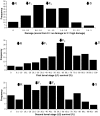QTL mapping of thrips resistance in pepper
- PMID: 26152569
- PMCID: PMC4572063
- DOI: 10.1007/s00122-015-2558-1
QTL mapping of thrips resistance in pepper
Abstract
A QTL for thrips resistance on pepper chromosome 6 was identified and validated. This QTL affects thrips larval development and explains 50% of the variation. Thrips is one of the most damaging pests in pepper (Capsicum). Resistance to thrips was identified in Capsicum annuum. This study was aimed at the elucidation of the genetic background of thrips resistance in Capsicum through QTL mapping. The QTL analysis was carried out for Frankliniella occidentalis resistance in an F2 population consisting of 196 plants derived from an interspecific cross between the highly resistant C. annuum AC 1979 as female parent and the highly susceptible C. chinense 4661 as male parent. Fifty-seven SSR, 109 AFLP, and 5 SNP markers were used to construct a genetic map with a total length of 1636 cM. Damage caused by larvae and the survival of first and second instar larval stages observed in a no-choice test were used as parameters of resistance. Interval mapping detected one QTL for each of these parameters, all co-localizing near the same marker on chromosome 6. Use of this marker as co-factor in a multiple-QTL mapping analysis failed to uncover any additional QTLs. This QTL explained about 50% of the genetic variation, and the resistance allele of this QTL was inherited from the resistant parent. Thrips resistance was not linked to trichome density.
Figures



References
-
- Allard RW. Principles of plant breeding. 2. New York: John Willey & Sons Inc.; 1999.
-
- Capinera JL. In: Order thysanoptera-thrips: Handbook of vegetable pests. Capinera JL, editor. San Diego: Academic Press; 2001. pp. 535–550.
-
- Fery RL, Schalk JM. Resistance in pepper (Capsicum annuum L.) to western flower thrips [Frankliniella occidentalis (Pergande)] HortScience. 1991;26:1073–1074.
Publication types
MeSH terms
Substances
LinkOut - more resources
Full Text Sources
Other Literature Sources
Miscellaneous

